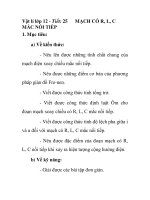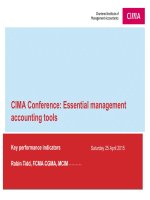25 legendary leadership activit peter r garber
Bạn đang xem bản rút gọn của tài liệu. Xem và tải ngay bản đầy đủ của tài liệu tại đây (818.11 KB, 186 trang )
25 Legendary Leadership
Activities
Peter R. Garber
HRD Press, Inc. • Amherst • Massachusetts
Copyright © 2008 by Peter R. Garber
The materials that appear in this book, other than those quoted from prior sources, may be
reproduced for educational/training activities. There is no requirement to obtain special
permission for such uses.
This permission statement is limited to reproduction of materials for educational or training
events. Systematic or large-scale reproduction or distribution—or inclusion of items in publications for sale—may be carried out only with prior written permission from the publisher.
Published by:
HRD Press, Inc.
22 Amherst Road
Amherst, Massachusetts 01002
1-800-822-2801 (U.S. and Canada)
413-253-3488
413-253-3490 (fax)
www.hrdpress.com
ISBN 978-1-59996-072-2
Production services by Jean Miller
Editorial services by Sally Farnham
Cover design by Eileen Klockars
Table of Contents
Introduction ......................................................................................
v
Activities
1
How do you spend your leadership time?..........................................
1
2
The “Plugged-In” Leader.............................................................
5
3
Managing out the Wazzoo ............................................................ 11
4
LeaderFear ............................................................................. 15
5
Legendary Leadership Questionnaire .............................................. 21
6
Legendary Leadership Hall of Fame ................................................ 25
7
Getting into a Management Rhythm................................................ 33
8
Leadership Building Blocks........................................................... 39
9
Leadership Vantage Points........................................................... 49
10
The Leadership Compass ............................................................. 53
11
Profiling Legendary Leaders ......................................................... 65
12
Managing Sideways .................................................................... 69
13
Leadership Roles....................................................................... 79
14
Leadership Decision Dynamics....................................................... 107
15
Making Difficult Leadership Decisions.............................................. 111
16
Leadership Breadth ................................................................... 115
17
Why Good Leaders Make Bad Decisions ............................................ 119
18
20 Questions You Should Ask Yourself When Making a Difficult Decision .... 125
19
Leading Outside the Box ............................................................. 129
20
Leadership Change Box ............................................................... 135
21
Leadership Image...................................................................... 147
22
Your Legendary Leaders.............................................................. 157
23
You as a Leader........................................................................ 163
24
Leadership Survival Skills ............................................................ 167
25
Collaborative Management .......................................................... 173
Introduction
Great leadership is important in any situation in which others look to you for guidance
and direction. Legendary leadership can be defined simply as leadership that is
remembered. Being remembered as a good or even a great leader is a likely goal of
anyone who aspires to this role or position in life. Legendary leadership is not limited
by the number of people one leads or the size of the organization. The qualities and
abilities that enable a leader to effectively lead a few people are the very same as
those required to lead a large organization or even a nation.
Each of these 25 Legendary Leadership Activities is designed to help you find the legendary leader inside you. Each activity focuses on a different leadership characteristic that can help you reach your greatest potential and your ultimate legacy as a
leader. May you find success in your life and career and learn lessons from these 25
activities that will help you reach your own personal leadership goals in the future.
Good luck in your legendary leadership journey.
Activity 1
How do you spend your leadership time?
Purpose
To provide participants the opportunity to complete an assessment that helps
them measure how they spend their leadership time
Description
There are many different activities that leaders must engage in on a daily basis in
order to perform their jobs. Certain jobs and situations often dictate which of
these activities is most important in relation to the others. One of the most
important skills for a leader to master is the ability to do the right things, at the
right time, in the right circumstances. Probably most leaders have never thought
about developing a self-assessment of their activities to understand how they
spend most of their time. By completing the following Leadership Activity Assessment, participants can get a better idea of what they are presently spending their
time on and if this is the best use of their time.
Time
45 minutes
Resources
Handout 1.1
Presentation
1. Ask participants if they feel they make the best or most efficient use of their
workday doing leadership activities.
2. Allow participants to spend a few moments commenting on how well they feel
they use their time as leaders.
3. Explain to participants that the purpose of this activity is to help them gain a
better understanding and measure of how they actually spend their leadership
time at work.
4. Distribute a copy of Handout 1.1 to each participant.
5. Instruct participants to assign a percentage for each of the leadership activities they presently engage in during a typical workday. The total should
account for 100 percent of their time.
(continued)
Activity 1
1
Activity 1 (concluded)
6. For each activity, have participants evaluate the relative value by assigning a
rating of high, medium, or low. This value rating should be based on the
activity’s importance or impact on each participant’s overall job performance.
7. Ask participants to look at the percentages they assigned to each activity.
8. Ask participants the following questions:
Y
“Are you spending enough time on the high value-added activities?”
Y
“If not, where are you spending the majority of your time?”
Y
“What would you be sacrificing if you spent less time on some of the less
important activities?”
Y
“What would be your ideal balance of time you spend on each of these
activities?”
Y
“What can you do to better allocate the use of your time on these valueadded activities?”
9. End the activity by emphasizing the importance of effective time management for a leader. Spending time doing the right things is one of the most
important tasks of a leader. Not only does this enable the leader to more
effectively and efficiently use his or her own leadership time, but it will also
help the leader focus those being led to spend their time more wisely as well.
2
25 Legendary Leadership Activities
Handout 1.1
Leadership Activities Assessment
% of Time
Activity
Activity Value
Making decisions
High Medium Low
Building/Nurturing working relationships
High Medium Low
Collecting/Analyzing data
High Medium Low
Learning new skills
High Medium Low
Communications (giving or receiving information)
High Medium Low
Conflict management
High Medium Low
Adapting to change
High Medium Low
Coaching others
High Medium Low
Crisis management
High Medium Low
Visioning
High Medium Low
Other (specify)
High Medium Low
Total (should = 100%)
Reprinted with permission of John Wiley & Sons, Inc.
2007 Pfeiffer Annual-Consulting Management Activities Assessment, by Peter R. Garber
Reproduced from 25 Legendary Leadership Activities,
Copyright © 2008, HRD Press, Inc., Amherst, MA, 01002, 1-800-822-2801
Activity 2
The “Plugged-In” Leader
Purpose
To illustrate the many different ways a leader can access information today
Description
The focus of the activity is to help participants learn to deal more effectively with
sources of information that oftentimes compete for their attention as leaders.
Time
45 minutes
Resources
Handouts 2.1 and 2.2
Presentation
1. Explain that the new communications technology available today is both a
blessing and a curse. Present the following points concerning the various ways
in which leaders receive information today:
Y
Communications tools become obsolete quickly—technology that amazes
us today, bores us tomorrow.
Y
Staying connected is not only becoming more complex, but more essential
every day.
Y
Communications challenges are on a whole new frontier.
Y
You now have multiple sources or portals coming at you at the same time,
often creating competing communications sources.
Y
Fighting this communications technology is a losing battle no matter how
powerful you may be in your organization.
Y
The most effective leaders of tomorrow will be those who understand how
to utilize these communications tools most effectively.
Y
With the communications tools available today, there should be no reason
for a presumption of ignorance on anybody’s part in the organization.
(continued)
Activity 2
5
Activity 2 (concluded)
Y
A leader should always be “plugged in” to what is going on in his or her
organization.
Y
If you as a leader feel that you are not getting enough or the right information, it is because you haven’t asked for it correctly.
Y
You need to utilize the vast array of communications tools available to
you today to ensure that you are getting the information you need as a
leader.
Y
The downside, or “curse,” of these new tools is information overload.
There are just so many ways in which you can receive information that it
can become mind boggling.
Y
You could spend all your time sifting through so many messages, delivered
in so many formats, that you can’t get anything else done.
Y
You may be fully informed at any given moment but become so burdened
by the process that you don’t have time to act or react to this information.
2. Distribute a copy of Handout 2.1 to each participant, which lists the many different ways or formats in which leaders might receive information today. Tell
participants they can expand this list based on their own experiences.
3. Distribute a copy of Handout 2.2 to each participant, and review each of the
five points covered in the handout.
Debrief
6
•
Emphasize to participants that they need to stay in control of these communications sources, not the other way around. Leaders shouldn’t allow these
sources of communication to run their business lives. Leaders need to instead
manage these sources of information so that they become productive and
effective business tools for leaders to use to their benefit.
•
Explain that setting parameters or rules on when and how participants receive
communications can be an effective method for managing these tools and
their leadership time.
25 Legendary Leadership Activities
Handout 2.1
Today’s Leadership Communications Tools
•
•
•
•
•
•
•
•
•
•
•
•
•
•
VMX
Meetings
Virtual tours
Webinars
Text messages
Chat rooms
Blogs
E-learning
Seminars
Conferences
Web sites
Faxes
Other:
•
•
•
•
•
•
•
•
•
•
•
•
•
Interoffice mail
Letters
Proposals
Briefings
Books
Articles
Media
Evaluations
Information requests
Technology updates
Reports
Presentations
Summaries
Reproduced from 25 Legendary Leadership Activities,
Copyright © 2008, HRD Press, Inc., Amherst, MA, 01002, 1-800-822-2801
Handout 2.2
Managing Your Communications Sources
So, how do you deal with all these demands on your time? Is it practical to ignore
these multiple sources of information competing for your time at the risk of missing
an important message? The best approach concerning this communications challenge
is to take control of your communications time. You need to stay in control of how
and when you receive information.
The following steps will help you take control of your communications time and
activities:
1. Discipline yourself not to constantly be checking for messages throughout your
working time.
2. Have others screen information from these various sources of communications
with instructions to alert you to anything that requires your immediate
knowledge or attention.
3. Don’t become addicted to your electronic communications tools even if you
have the latest and greatest on the market today.
4. Don’t let your latest electronic communications gadget manage you. There
are still many other very important things that you must do on a regular basis
to be an effective manager.
5. Let others who work for you know what your communications “habits” are
such as checking your messages at the beginning, middle, or end of the day.
Set certain parameters that others can rely on when expecting a response
from you.
Reproduced from 25 Legendary Leadership Activities,
Copyright © 2008, HRD Press, Inc., Amherst, MA, 01002, 1-800-822-2801
Activity 3
Managing out the Wazzoo
Purpose
To provide a more humorous perspective of what it is like to manage in today’s
increasingly demanding work world
Description
The term wazzoo is introduced as a management concept of sorts. The catch
phrase managing out the wazzoo is presented in a short description of the
increasing pressures that managers and leaders face today. It is ultimately left up
to the reader to interpret what managing out the wazzoo truly means, but the
concept itself is one that practically anyone working in a leadership role today
can easily relate to their own situation.
Time
20 minutes
Resources
Handout 3.1
Presentation
1. Distribute or display Handout 3.1.
2. Lead a discussion concerning the following concepts presented in the handout:
Y
A wazzoo represents those ambiguous situations in which leaders often
have to make difficult decisions based on incomplete data.
Y
Learning to manage out your wazzoo may not be something that can be
taught to you, but rather something you need to learn to do for yourself.
Y
Finding your management wazzoo can be one of the best things you can
do for yourself as a leader.
Y
The best leaders probably have found their management wazzoos and use
them regularly.
Debrief
Ask participants to share what their perception of a management wazzoo
would be.
Activity 3
11
Handout 3.1
Managing out the Wazzoo
There is an expression in business that sometimes you just have to “manage out the
wazzoo” to keep up today. Just what is a wazzoo anyway? This is a good question. An
even better question is why would anyone want to learn to manage out of one? A wazzoo appears to be something that everyone seems to know about, but isn’t exactly
sure precisely what it refers to. Wazzoo has become an increasingly popular term
today. For example, you might hear, “He has money coming out the wazzoo.” There
was even a television commercial based on this theme where a man is being wheeled
facedown into an operating room, his derrière exposed, and with grim-looking surgeons posed ready to operate on the patient because he is afflicted with money coming out his wazzoo. The commercial was for an investment company apparently hoping that viewers would want to be afflicted with this same ailment—perhaps a bit of a
stretch in consumer marketing.
What managing out the wazzoo really means is dealing effectively with the challenges
with which you are faced in the business world on a daily basis when there are no
clear-cut answers available. The successful leader today does manage out the wazzoo, or whatever you want to call that place that he or she must find within to come
up with the best answers to difficult questions and problems. As we move forward
into this new century, the answers will get even tougher to find. Technology will
undoubtedly move us ahead at speeds we could not have even fathomed just a few
years ago. You need to figure out what is your wazzoo and learn to manage out of it
if you ever expect to keep up with all the challenges you will face in the future as a
leader. No one can teach you how to use your wazzoo. You need to discover your
wazzoo for yourself. Once you identify your wazzoo, use it whenever you find yourself
in those difficult dilemmas where there are no clear-cut answers. The best leaders
have a good wazzoo when it comes to dealing with difficult challenges.
Reproduced from 25 Legendary Leadership Activities,
Copyright © 2008, HRD Press, Inc., Amherst, MA, 01002, 1-800-822-2801
Activity 4
LeaderFear
Purpose
To introduce the concept of LeaderFear to participants and why it is important to
understand
Description
The concept of LeaderFear is defined and explored in this activity. LeaderFear
can be defined as the fear that leaders intentionally or unintentionally create as a
means to reach organizational and personal goals. The activity describes the pitfalls of LeaderFear and why it is not an effective long-term management philosophy.
Time
45 minutes
Resources
Handouts 4.1 and 4.2
Presentation
1. Explain that LeaderFear can be defined as the fear that leaders intentionally
or unintentionally create as a means to reach organizational and personal
goals.
2. Distribute a copy of Handout 4.1 to each participant, or present the information on Handout 4.1 as a lecture.
3. Briefly review the major points of the handout:
Y
The unfortunate fact is that LeaderFear can get the job done.
Y
Although it can be effective, fear is not an efficient motivator, at least
not in the long run.
Y
Fear gets people’s attention and causes a definite reaction.
Y
Fear may get people to act, but eliminating or reducing this fear factor
will actually improve performance in the long run.
Y
Leaders may have legitimate reasons, on occasion, to become angry. They
may need to take aggressive and stern actions at times that are appropriate for the situation.
(continued)
Activity 4
15
Activity 4 (concluded)
Y
When done responsibly and rationally, these actions are accepted and
even respected by the people in the organization.
Y
However, when a leader is known for constantly losing his or her temper
without justification, a problem definitely exists. A hostile work environment is created.
4. Distribute a copy of Handout 4.2 to each participant and ask each one to complete the questionnaire.
5. Being sensitive to the fact that there might be information shared in this
handout, ask for volunteers to discuss the questions.
6. Instead of specifics, ask participants in general how they feel about the
effects LeaderFear can have on an organization and its consequences.
Debrief
Ask participants if they think LeaderFear can be reduced in an organization and
what are the potential benefits of reducing this fear factor.
16
25 Legendary Leadership Activities
Handout 4.1
LeaderFear
LeaderFear can be defined as the fear that leaders intentionally or unintentionally
create as a means to reach organizational and personal goals. Unfortunately, this is an
experience that every employee has endured at some point in his or her career. In
fact, experiencing LeaderFear at some point in one’s career may cause this behavior
to be repeated later on in one’s career in a leadership role. Fear may never fall far
from the tree as future leaders often model their management styles after leaders to
whom they reported earlier in their careers, and whom they emulate.
The unfortunate fact is that LeaderFear can get the job done. Although it can be
effective, fear is not an efficient motivator, at least not in the long run. It gets people’s attention and causes a definite reaction. Fear may get people to act, but eliminating or reducing this fear factor will actually improve performance, reduce churn
and wasted resources, greatly improve employees’ attitude and morale throughout
the organization, and dramatically change the culture of the organization.
Leaders may have legitimate reasons on occasion to become angry. They may need to
take aggressive and stern actions at times that are appropriate for the situation.
When done responsibly and rationally, these actions are accepted and even respected
by the people in the organization. However, when a leader is known for constantly
losing his or her temper without justification, a problem definitely exists. A hostile
work environment is created. Working for such a leader can be like being in an abusive relationship. Fear can be the ultimate control mechanism. Leaders who constantly use fear to get people to do what they want them to do actually put themselves in a weakened position. People begin to respond to the boss’s moods rather
than the real issues at hand. Creating an atmosphere of blind obedience or even a
culture based on LeaderFear will extinguish subordinate-to-boss feedback. The question that is asked among employees each morning is usually, “What kind of mood is he
in today?” rather than a discussion of the issues relating to the day’s challenges facing
the organization. People in the organization become more expert at managing the
boss’s moods than managing the business.
Reproduced from 25 Legendary Leadership Activities,
Copyright © 2008, HRD Press, Inc., Amherst, MA, 01002, 1-800-822-2801
Handout 4.2
LeaderFear Questionnaire
1. How great a factor do you believe fear plays in the culture of your organization
and why do you believe this to be true?
2. What are some examples of this fear dictating important decisions in your organization?
3. How differently do you think these decisions would have been if this fear factor
had not been present?
4. How could fear be reduced in your organization?
(continued)
Reproduced from 25 Legendary Leadership Activities,
Copyright © 2008, HRD Press, Inc., Amherst, MA, 01002, 1-800-822-2801









